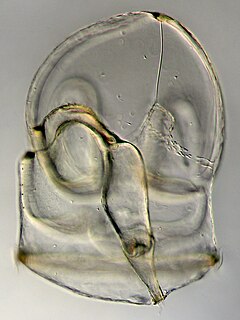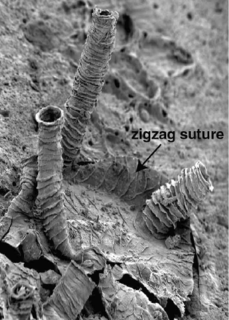
Hemichordata is a phylum of marine deuterostome animals, generally considered the sister group of the echinoderms. They appear in the Lower or Middle Cambrian and include two main classes: Enteropneusta, and Pterobranchia. A third class, Planctosphaeroidea, is known only from the larva of a single species, Planctosphaera pelagica. The extinct class Graptolithina is closely related to the pterobranchs.

Graptolithina is a subclass of the class Pterobranchia, the members of which are known as graptolites. These organisms are colonial animals known chiefly as fossils from the Middle Cambrian through the Lower Carboniferous (Mississippian). A possible early graptolite, Chaunograptus, is known from the Middle Cambrian. One analysis suggests that the pterobranch Rhabdopleura represents extant graptolites. Studies on the tubarium of fossil and living graptolites showed similarities in the basic fusellar construction and it is considered that the group most probably evolved from a Rhabdopleura-like ancestor.

Entoprocta, or Kamptozoa, is a phylum of mostly sessile aquatic animals, ranging from 0.1 to 7 millimetres long. Mature individuals are goblet-shaped, on relatively long stalks. They have a "crown" of solid tentacles whose cilia generate water currents that draw food particles towards the mouth, and both the mouth and anus lie inside the "crown". The superficially similar Bryozoa (Ectoprocta) have the anus outside a "crown" of hollow tentacles. Most families of entoprocts are colonial, and all but 2 of the 150 species are marine. A few solitary species can move slowly.

A cephalochordate is an animal in the chordate subphylum, Cephalochordata. They are commonly called Amphioxus or lancelets. Cephalochordates possess 5 synapomorphies, or primary characteristics, that all chordates have at some point during their larval or adulthood stages. These 5 synapomorphies include a notochord, dorsal hollow nerve cord, endostyle, pharyngeal slits, and a post-anal tail . The fine structure of the cephalochordate notochord is best known for the Bahamas lancelet, Asymmetron lucayanum. Cephalochordates are represented in modern oceans by the Amphioxiformes and are commonly found in warm temperate and tropical seas worldwide. With the presence of a notochord, adult amphioxus are able to swim and tolerate the tides of coastal environments, but they are most likely to be found within the sediment of these communities.

Balanoglossus is an ocean-dwelling(only Marine water dwelling, not fresh water dwelling) acorn worm (Enteropneusta) genus of great zoological interest because, being a Hemichordate, it is an "evolutionary link" between invertebrates and vertebrates. Balanoglossus is a deuterostome, and resembles the Ascidians or sea squirts, in that it possesses branchial openings, or "gill slits". It has notochord in the upper part of the body and has no nerve chord. It does have a stomochord, however, which is gut chord within the collar. Their heads may be as small as per 2.5 mm (1/10 in) or as large as 5 mm (1/5 in).

Pterobranchia is a class of small worm-shaped animals. They belong to the Hemichordata, and live in secreted tubes on the ocean floor. Pterobranchia feed by filtering plankton out of the water with the help of cilia attached to tentacles. There are about 25 known living pterobranch species in three genera, which are Rhabdopleura, Cephalodiscus, and Atubaria. On the other hand, there are several hundred extinct genera, some of which date from the Cambrian Period.

The acorn worms or Enteropneusta are a hemichordate class of invertebrates consisting of one order of the same name. The closest non-hemichordate relatives of the Enteropneusta are the echinoderms. There are 111 known species of acorn worm in the world, the main species for research being Saccoglossus kowalevskii. Two families—Harrimaniidae and Ptychoderidae—separated at least 370 million years ago.

Phoronids are a small phylum of marine animals that filter-feed with a lophophore, and build upright tubes of chitin to support and protect their soft bodies. They live in most of the oceans and seas, including the Arctic Ocean but excluding the Antarctic Ocean, and between the intertidal zone and about 400 meters down. Most adult phoronids are 2 cm long and about 1.5 mm wide, although the largest are 50 cm long.

Brachiopods, phylum Brachiopoda, are a group of lophotrochozoan animals that have hard "valves" (shells) on the upper and lower surfaces, unlike the left and right arrangement in bivalve molluscs. Brachiopod valves are hinged at the rear end, while the front can be opened for feeding or closed for protection. Two major groups are recognized, articulate and inarticulate. The word "articulate" is used to describe the tooth-and-groove features of the valve-hinge which is present in the articulate group, and absent from the inarticulate group. This is the leading diagnostic feature (fossilizable), by which the two main groups can be readily distinguished. Articulate brachiopods have toothed hinges and simple opening and closing muscles, while inarticulate brachiopods have untoothed hinges and a more complex system of muscles used to keep the two valves aligned. In a typical brachiopod a stalk-like pedicle projects from an opening in one of the valves near the hinges, known as the pedicle valve, keeping the animal anchored to the seabed but clear of silt that would obstruct the opening.

Cephalodiscida is one of two orders in the class Pterobranchia, which are small, worm-shaped animals. Members belong to the hemichordates. Species in this order are sessile, living in clear water and secrete tubes on the ocean floor.

Rhabdopleurida is one of three orders in the class Pterobranchia, which are small, worm-shaped animals. Members belong to the hemichordates. Species in this order are sessile, colonial, connected with a stolon, living in clear water and secrete tubes called tubarium. They have a single gonad, the gill slits are absent and the collar has two tentaculated arms. Rhabdopleura is the best studied pterobranch in developmental biology. Some claim Rhabdopleura is an extant graptolite.

Rhabdopleura is a genus of colonial sessile hemichordates belonging to the Pterobranchia class. As one of the oldest living genera with a fossil record dating back to the Middle Cambrian, it is also considered to be the only living genus of graptolites.

A tornaria is the planktonic larva of some species of Hemichordata such as the acorn worms. It is very similar in appearance to the bipinnaria larvae of starfishes, with convoluted bands of cilia running around the body. It is an oval shaped, transparent larva. The diameter of the body is about 3 mm. It has an apical plate, which is a thickened region provided by a tuft of cilia and a pair of eye spots. The larva has a complete alimentary canal. The ciliary band stretches throughout the anterior and posterior region, and also the postoral region.

Cephalodiscus is a genus of hemichordates in the monotypic family Cephalodiscidae of the order Cephalodiscida.
The Cephalodiscidae mitochondrial code is a genetic code used by the mitochondrial genome of Cephalodiscidae (Pterobranchia). The Pterobranchia are one of the two groups in the Hemichordata which together with the Echinodermata and Chordata form the major clades of deuterostomes.
Pseudoceros canadensis is a species of free-living, flatworm in the genus Pseudoceros, belonging to the family Pseudocerotidae.
Rhabdopleura annulata is a sessile hemichordate. It is a suspension feeder that secretes tubes on the ocean floor.

Rhabdopleura compacta is a sessile hemichordate. It is a suspension feeder that secretes tubes on the ocean floor.
Rhabdopleura striata is a sessile hemichordate. It is a suspension feeder that secretes tubes on the ocean floor.
Rhabdopleura recondita is a sessile hemichordate. It is a suspension feeder that secretes tubes on the ocean floor. It is found in the Adriatic and Ionian Seas.











